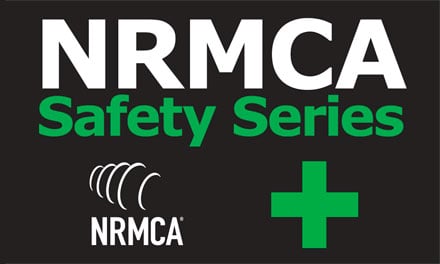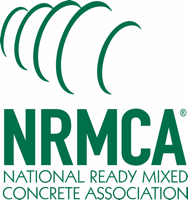Available on USB flash drives…


(click on title to order)
Working Safely On and Around Mixer Trucks
According to OSHA, slips, trips and falls constitute the majority of workplace accidents. That includes 15% of all workplace deaths. As a result, this lesson discusses safe practices for mixer truck drivers who climb up and down steps and ladders to their truck cabs and discharge hoppers approximately 10 times a day. It reviews and emphasizes the use of three points of contact and various safety procedures on and working around mixer trucks when mounting or dismounting these vehicles. Additionally, the lesson covers ergonomic best practices to help mitigate possible muscle strains, sprains, or tears due to repetitive actions while working on and around a mixer. >>Preview Clip
Concrete Mixer Truck Rules for Using a Backing Spotter
Mixer drivers learn seven steps to use when working with a spotter, including proper hand and arms signals as well as blind spot awareness tips. Appropriate for front and rear discharge mixers. >>Preview Clip
Respiratory Protection Program
This video lesson discusses respiratory protection programs as established by the Occupational Safety and Health Administration or OSHA, found in the Code of Federal Regulations at Title 29, Section 1019. 134. It includes the background of respiratory protection and how to determine if respiratory protection applies to your ready mixed concrete operation. It also covers the common areas of a plant that require respiratory protection, pre- and post- use inspection, maintenance, cleaning and storing of respiratory protection, the required medical questionnaire and employee medical clearance procedures, the two forms of respirator fit-testing, along with cartridge selection, and the required training ready mixed concrete companies must complete. Additionally, it discusses the respiratory protection program basics that likely will be part of any written exposure plan for compliance with OSHA’s new silica rule. >>Preview Clip
Working Safely Around Concrete Pumps
This two-part, 25 minute lesson focuses on the unique and critical factors that mixer drivers must be aware of at a pump job. It includes concrete pump basics, safety factors to consider before discharging concrete on a pump job, placing concrete safely on a pump job, and the special safety hazards that require extra caution, including electrical hazards through power lines as well as possible hose whip due to the high pressure used in modern pumps. Finally, the video contains communication tips for the driver when working with the site superintendent or coordinator, the pump operator, pump operator assistant, and site workers so everyone goes home safely at the end of the day. >>Preview Clip
Pre-Trip Inspection for the Rear Discharge Mixer Truck
Following the guidelines in Federal Motor Carriers Safety Administration’s 49 CRF, Part 396, this comprehensive lesson reviews the daily, seven-step procedure to correctly inspect the truck as well as the mixer. With the sole focus of the lesson on a rear discharge mixer truck, a driver will learn how to develop a safe, routine, and thorough working knowledge of the vehicle. Additional steps are included for rear discharge mixer trucks with liftable axels. >>Preview Clip
Pre-Trip Inspection for the Front Discharge Mixer Truck
Following the guidelines in Federal Motor Carriers Safety Administration’s 49 CRF, Part 396, this comprehensive lesson reviews the daily, seven-step procedure to correctly inspect the truck as well as the mixer. With the sole focus of the lesson on a front discharge mixer truck, a driver will learn how to develop a safe, routine, and thorough working knowledge of the vehicle. Additional inspection steps are included for front discharge mixer trucks with liftable axels. >>Preview Clip
Preparing for an OSHA Plant Inspection
If you think OSHA will never visit one of your plants, think again. An average of 70,000 unannounced inspections happen a year between state and federal OSHA agencies. As a result, this video covers the basics you need to know about OSHA’s inspection and enforcement protocol, their expectations, and specifically, the steps in an onsite inspection. Remember, how well you survive is directly proportional to how well you prepare. This video is a great place to start. >>Preview Clip
Mixer Truck Washout
Over time, the ready mixed concrete industry developed a best practice system to remove the daily concrete build-up in mixer trucks. It not only helps truck maintenance, it also reduces chipping and the amount of costly water. Therefore, this lesson focuses on what drivers and concrete producers need to consider for mixer truck washout once a truck arrives back at the ready-mix plant. Considerations in this video include returned concrete management, portable chute rinse-off management, the steps associated with mixer truck washout and the different types of equipment companies are using to assist with mixer truck washout. >>Preview Clip
Part 1: Lockout/Tryout/Tagout in the RMC Industry
This 28-minute video lesson explains the Federal OSHA Standard of Control of Hazardous Energy as it specifically relates to compliance procedures and best practice for the ready mixed concrete industry. >>Preview Clip
Part 2: Lockout/Tryout/Tagout in the RMC Industry
How does a producer handle shift changes as well as outside contractors? What’s the regulation state about a producer’s duty when buying new equipment? What are the rules as they relate to old machinery that can’t be locked out? How do you assure your lockout/tagout system is in compliance and how does that relate to training your employees? >>Preview Clip
Jobsite Chute Rinse-off
Drivers will learn the correct way to handle chute rinse-off at a construction site. The video details various methods drivers can use to get their chutes clean while not violating environmental regulations. It also discusses the driver’s responsibility to adapt to each job site’s requirements and when to notify the company if there is a problem. Finally, the lesson points out that chute rinse-off plays a role in fleet maintenance as well as being a safety factor, in that rinsing off a chute correctly prevents debris from hitting other vehicles as the mixer returns to the plant. >>Preview Clip
Backing Accident Prevention Program
Mixer drivers learn about the root causes of backing accidents and 11 prevention tips. Appropriate for front and rear discharge mixers. >>Preview Clip
NRMCA Ready Mixed Concrete Plant Safety
The 15 minute complementary video provides a broad oversight of the most critical safety factors at a ready mixed concrete plant. Whether a plant operator, yardman, mechanic, or concrete delivery professional, the lesson helps the viewer understand and incorporate the basic safety procedures required at all times. With as much activity at a plant as a small city, the audience is exposed to the consequential safety essentials, from daily plant start-up to plant shut-down. Specifically, the lesson includes an overview of proper personal protective equipment, plant safety signage, general plant safety inspections protocols, lockout/tagout /and tryout of power sources, inspection and repair of conveyors, confined spaces, dust collection systems and baghouses inspections, slips, trips, and falls prevention, and general plant housekeeping.
